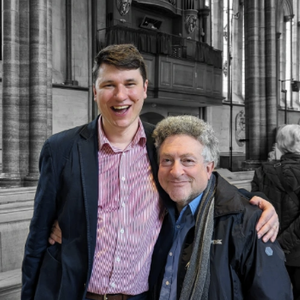Jonathan Clinch, organ
How to buy
| streaming | YouTube | Find out more |
| streaming | YouTube | Find out more |
| streaming | YouTube | Find out more |
| streaming | YouTube | Find out more |
| streaming | YouTube | Find out more |
Performers
Description
Composer Robert Saxton (Emeritus Professor, Oxford University) was appointed Honorary Research Fellow at the Royal Academy of Music in 2021 as part of a collaborative project with Dr Jonathan Clinch looking at the new compositional possibilities of digital instruments using Hauptwerk software. This included writing a new organ cycle for Dr Clinch and collaborating on recordings of his existing works.
Organ Cycle – The Reckoning of Time
Programme Note by Robert Saxton.
The Reckoning of Time was commissioned by Dr Jonathan Clinch in 2021 and completed in 2024 as a research project supported by the Royal Academy of Music, London.
The title is taken from the writings of Bede, the eight century AD English monk and historian, in which he addressed the matter of the organization of the church year and its cycles in astronomical/mathematical detail. I came across the latter after completing the music in a fascinating book Winters in the World by Eleanor Parker (Oxford University) concerning the seasonal cycles of the Anglo-Saxon year. Bede’s tomb is in Durham Cathedral, and it was at Durham University that Jonathan Clinch undertook his PhD, so the reference seemed both natural and apt.
Since I was in my early teens, I have been drawn to the organ music of Dietrich Buxtehude, with its lightness and airy quality, combined with its seemingly effortless counterpoint and harmonic beauty. Similar qualities are also apparent in earlier composers such as Cabazon and Frescobaldi, in the organ works of de Grigny and in the trio sonatas of JS Bach. Whether or not these qualities inhere in my cycle is not for me to judge.
In order to achieve the character and sound world for each movement, I was fortunate to work closely with Jonathan Clinch who, from his studio, using Hauptwerk technology, was able to offer the sound of various organs from varying eras across Europe, transforming the ‘ambient’ acoustics as necessary. After much experimentation, he decided to record using sound files (created by Piotr Grabowski) from the organ in the Annakirche, Duren, in Westphalia, Germany. The church was destroyed by Allied bombing during World War 2, being subsequently re-built between 1954 and 1956. The organ, by the Swiss maker, Metzler, dates from 2010.
By choosing this instrument, Jonathan Clinch has underlined the principal idea behind the music of renewal and a sense of continuity, in a similar spirit to that which was at the heart of the re-building of St Michael’s Cathedral, Coventry (1962) after its destruction by the Luftwaffe during World War 2. It is both profound and optimistic as a reciprocal gesture.
The Reckoning of Time is written for and dedicated to Dr Jonathan Clinch in admiration and gratitude, in addition to his encouragement, patience and technical brilliance. There is also a secondary dedication to Jessie and Arthur Holmes who, in the late 1950s and 1960s, both supported my grandparents in their house in Norwich. Arthur was an outstanding plantsman and gardener as well as being the calmest, most thoughtful and radiantly humble person I have ever met. Apart from nature and gardens, his delight was to listen to organ music in Norwich Cathedral and, so, the cycle is dedicated to the memory of his wife and him who both enlightened my childhood.
The ten movements of the cycle are as follows:
Awakening: Prelude, symbolically concerned with dawn and new beginnings.
Echoing Voices: imitative/canonic/heterophonic reflection on Time’s echoes across the ages.
Toccata of Light: the music symbolizes the sparkle and rapidity of Light (and its symbolic importance in the Judeo-Christian tradition) invariably appearing to change in quality, but unchanging as regards velocity.
Meditation on the Autumn Equinox: as the title implies, a sense of balance and post-summer calm in the transition to winter.
Song: a lyrical expression of one of the ways in which we, as humans, express our gratitude and joy in the context of nature and the seasonal round.
Dance: both a companion piece and contrast to Song. In this case, by means of the whole body.
Winter Solstice: the music proportionally reflects the short day in contrast to the long night (light and dark).
Celebration: Spring Equinox: as opposed to the valedictory Meditation at the Autumn Equinox, the music in this case heralds the time of re-birth and growth, also illustrating the ‘equality’ of the hours of daylight and darkness.
Processional: a prelude to the fruition of summer as an imagined ceremonial.
Summer Solstice: as with Winter Solstice, the music’s proportions illustrate the relatively brief night with the extended hours of daylight, closing the cycle in a spirit of affirmation and hopefulness.
Includes

The Reckoning of Time
Robert Saxton

